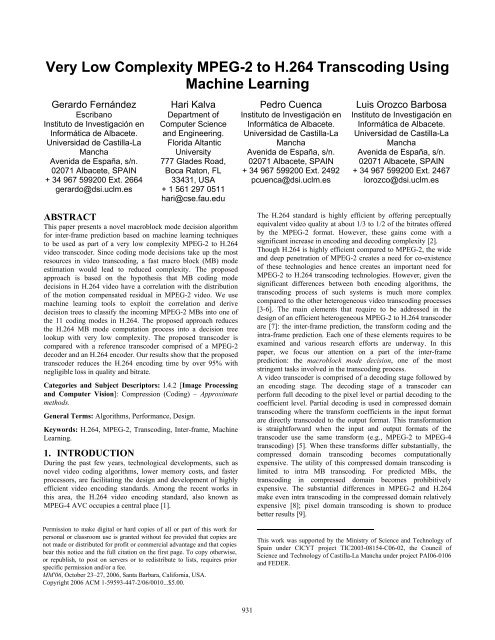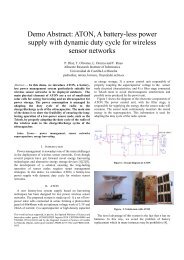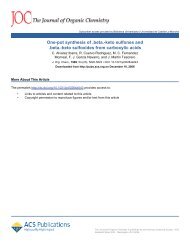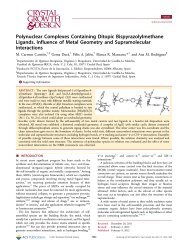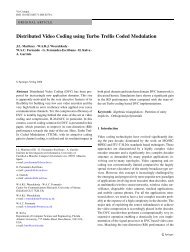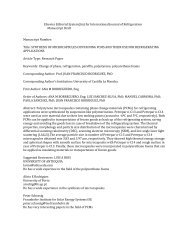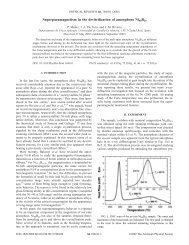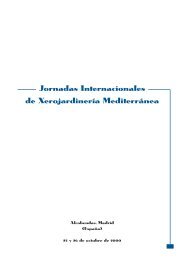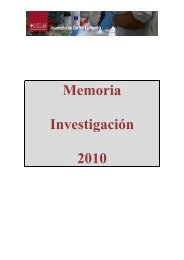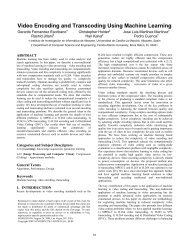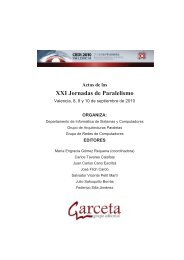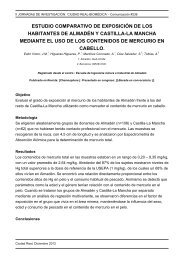Very Low Complexity MPEG-2 to H.264 Transcoding Using Machine ...
Very Low Complexity MPEG-2 to H.264 Transcoding Using Machine ...
Very Low Complexity MPEG-2 to H.264 Transcoding Using Machine ...
You also want an ePaper? Increase the reach of your titles
YUMPU automatically turns print PDFs into web optimized ePapers that Google loves.
<strong>Very</strong> <strong>Low</strong> <strong>Complexity</strong> <strong>MPEG</strong>-2 <strong>to</strong> <strong>H.264</strong> <strong>Transcoding</strong> <strong>Using</strong><br />
<strong>Machine</strong> Learning<br />
Gerardo Fernández<br />
Escribano<br />
Institu<strong>to</strong> de Investigación en<br />
Informática de Albacete.<br />
Universidad de Castilla-La<br />
Mancha<br />
Avenida de España, s/n.<br />
02071 Albacete, SPAIN<br />
+ 34 967 599200 Ext. 2664<br />
gerardo@dsi.uclm.es<br />
Hari Kalva<br />
Department of<br />
Computer Science<br />
and Engineering.<br />
Florida Altantic<br />
University<br />
777 Glades Road,<br />
Boca Ra<strong>to</strong>n, FL<br />
33431, USA<br />
+ 1 561 297 0511<br />
hari@cse.fau.edu<br />
ABSTRACT<br />
This paper presents a novel macroblock mode decision algorithm<br />
for inter-frame prediction based on machine learning techniques<br />
<strong>to</strong> be used as part of a very low complexity <strong>MPEG</strong>-2 <strong>to</strong> <strong>H.264</strong><br />
video transcoder. Since coding mode decisions take up the most<br />
resources in video transcoding, a fast macro block (MB) mode<br />
estimation would lead <strong>to</strong> reduced complexity. The proposed<br />
approach is based on the hypothesis that MB coding mode<br />
decisions in <strong>H.264</strong> video have a correlation with the distribution<br />
of the motion compensated residual in <strong>MPEG</strong>-2 video. We use<br />
machine learning <strong>to</strong>ols <strong>to</strong> exploit the correlation and derive<br />
decision trees <strong>to</strong> classify the incoming <strong>MPEG</strong>-2 MBs in<strong>to</strong> one of<br />
the 11 coding modes in <strong>H.264</strong>. The proposed approach reduces<br />
the <strong>H.264</strong> MB mode computation process in<strong>to</strong> a decision tree<br />
lookup with very low complexity. The proposed transcoder is<br />
compared with a reference transcoder comprised of a <strong>MPEG</strong>-2<br />
decoder and an <strong>H.264</strong> encoder. Our results show that the proposed<br />
transcoder reduces the <strong>H.264</strong> encoding time by over 95% with<br />
negligible loss in quality and bitrate.<br />
Categories and Subject Descrip<strong>to</strong>rs: I.4.2 [Image Processing<br />
and Computer Vision]: Compression (Coding) – Approximate<br />
methods.<br />
General Terms: Algorithms, Performance, Design.<br />
Keywords: <strong>H.264</strong>, <strong>MPEG</strong>-2, <strong>Transcoding</strong>, Inter-frame, <strong>Machine</strong><br />
Learning.<br />
1. INTRODUCTION<br />
During the past few years, technological developments, such as<br />
novel video coding algorithms, lower memory costs, and faster<br />
processors, are facilitating the design and development of highly<br />
efficient video encoding standards. Among the recent works in<br />
this area, the <strong>H.264</strong> video encoding standard, also known as<br />
<strong>MPEG</strong>-4 AVC occupies a central place [1].<br />
Permission <strong>to</strong> make digital or hard copies of all or part of this work for<br />
personal or classroom use is granted without fee provided that copies are<br />
not made or distributed for profit or commercial advantage and that copies<br />
bear this notice and the full citation on the first page. To copy otherwise,<br />
or republish, <strong>to</strong> post on servers or <strong>to</strong> redistribute <strong>to</strong> lists, requires prior<br />
specific permission and/or a fee.<br />
MM'06, Oc<strong>to</strong>ber 23–27, 2006, Santa Barbara, California, USA.<br />
Copyright 2006 ACM 1-59593-447-2/06/0010...$5.00.<br />
Pedro Cuenca<br />
Institu<strong>to</strong> de Investigación en<br />
Informática de Albacete.<br />
Universidad de Castilla-La<br />
Mancha<br />
Avenida de España, s/n.<br />
02071 Albacete, SPAIN<br />
+ 34 967 599200 Ext. 2492<br />
pcuenca@dsi.uclm.es<br />
931<br />
Luis Orozco Barbosa<br />
Institu<strong>to</strong> de Investigación en<br />
Informática de Albacete.<br />
Universidad de Castilla-La<br />
Mancha<br />
Avenida de España, s/n.<br />
02071 Albacete, SPAIN<br />
+ 34 967 599200 Ext. 2467<br />
lorozco@dsi.uclm.es<br />
The <strong>H.264</strong> standard is highly efficient by offering perceptually<br />
equivalent video quality at about 1/3 <strong>to</strong> 1/2 of the bitrates offered<br />
by the <strong>MPEG</strong>-2 format. However, these gains come with a<br />
significant increase in encoding and decoding complexity [2].<br />
Though <strong>H.264</strong> is highly efficient compared <strong>to</strong> <strong>MPEG</strong>-2, the wide<br />
and deep penetration of <strong>MPEG</strong>-2 creates a need for co-existence<br />
of these technologies and hence creates an important need for<br />
<strong>MPEG</strong>-2 <strong>to</strong> <strong>H.264</strong> transcoding technologies. However, given the<br />
significant differences between both encoding algorithms, the<br />
transcoding process of such systems is much more complex<br />
compared <strong>to</strong> the other heterogeneous video transcoding processes<br />
[3-6]. The main elements that require <strong>to</strong> be addressed in the<br />
design of an efficient heterogeneous <strong>MPEG</strong>-2 <strong>to</strong> <strong>H.264</strong> transcoder<br />
are [7]: the inter-frame prediction, the transform coding and the<br />
intra-frame prediction. Each one of these elements requires <strong>to</strong> be<br />
examined and various research efforts are underway. In this<br />
paper, we focus our attention on a part of the inter-frame<br />
prediction: the macroblock mode decision, one of the most<br />
stringent tasks involved in the transcoding process. †‡<br />
A video transcoder is comprised of a decoding stage followed by<br />
an encoding stage. The decoding stage of a transcoder can<br />
perform full decoding <strong>to</strong> the pixel level or partial decoding <strong>to</strong> the<br />
coefficient level. Partial decoding is used in compressed domain<br />
transcoding where the transform coefficients in the input format<br />
are directly transcoded <strong>to</strong> the output format. This transformation<br />
is straightforward when the input and output formats of the<br />
transcoder use the same transform (e.g., <strong>MPEG</strong>-2 <strong>to</strong> <strong>MPEG</strong>-4<br />
transcoding) [5]. When these transforms differ substantially, the<br />
compressed domain transcoding becomes computationally<br />
expensive. The utility of this compressed domain transcoding is<br />
limited <strong>to</strong> intra MB transcoding. For predicted MBs, the<br />
transcoding in compressed domain becomes prohibitively<br />
expensive. The substantial differences in <strong>MPEG</strong>-2 and <strong>H.264</strong><br />
make even intra transcoding in the compressed domain relatively<br />
expensive [8]; pixel domain transcoding is shown <strong>to</strong> produce<br />
better results [9].<br />
This work was supported by the Ministry of Science and Technology of<br />
Spain under CICYT project TIC2003-08154-C06-02, the Council of<br />
Science and Technology of Castilla-La Mancha under project PAI06-0106<br />
and FEDER.
Pixel domain transcoders have a full decoding stage followed by a<br />
reduced complexity encoding stage. The complexity reduction is<br />
achieved by reusing the information gathered from the decoding<br />
stage. It is assumed that the input video is encoded with<br />
reasonable RD optimization. The <strong>MPEG</strong>-2 <strong>to</strong> <strong>H.264</strong> complexity<br />
reduction techniques reported in the literature fall in<strong>to</strong> two<br />
categories: 1) MB mode mapping in <strong>H.264</strong> based on the MB<br />
modes of the incoming video [10] and 2) Selective evaluation of<br />
MB modes in <strong>H.264</strong> based on heuristics [11]. Because of the large<br />
number of inter and intra MB coding modes supported by <strong>H.264</strong>,<br />
there is no one-<strong>to</strong>-one mapping between <strong>MPEG</strong>-2 and <strong>H.264</strong> MB<br />
modes. A direct mapping leads <strong>to</strong> either a sub-optimal decision if<br />
the mapped mode is the final MB mode or an increase on<br />
complexity if additional evaluations have <strong>to</strong> be made <strong>to</strong> improve<br />
the mode decision. Selective evaluation is based on the<br />
observation that certain MB modes are less likely <strong>to</strong> occur for a<br />
class of videos and bitrates. If the selective evaluation is<br />
aggressive in limiting the number of allowed modes, the<br />
performance is sub-optimal. On the contrary, increasing the<br />
number of allowed modes increases the complexity.<br />
We have developed an innovative approach that is not limited by<br />
the inefficiencies of mode mapping or selective evaluation<br />
approaches. The proposed approach is based on the hypothesis<br />
that MB coding mode decisions in <strong>H.264</strong> video have a correlation<br />
with the distribution of the motion compensated residual in<br />
<strong>MPEG</strong>-2 video. Exploiting this correlation <strong>to</strong>gether with the MB<br />
coding modes of <strong>MPEG</strong>-2 could lead <strong>to</strong> a very low complexity<br />
transcoder. Figure 1 shows a plot of the mean and variance of the<br />
<strong>MPEG</strong>-2 MB residual in the input video and the <strong>H.264</strong> MB<br />
coding mode of the corresponding MB in the transcoded video.<br />
As the coding mode changes, the shift in the mean and variance of<br />
the corresponding MB can be clearly seen. This correlation can be<br />
effectively exploited using machine learning approaches. Thus,<br />
the <strong>H.264</strong> MB mode computation problem is posed as a data<br />
classification problem where the <strong>MPEG</strong>-2 MB coding mode and<br />
residual have <strong>to</strong> be classified in<strong>to</strong> one of the several <strong>H.264</strong> coding<br />
modes. The proposed transcoder is developed based on these<br />
principles and reduces the <strong>H.264</strong> MB mode computation process<br />
in<strong>to</strong> a decision tree lookup with very low complexity.<br />
Variance<br />
Mean<br />
<strong>MPEG</strong>-2 Res. MB Var.<br />
<strong>H.264</strong> MB Mode<br />
<strong>MPEG</strong>-2 Res. MB Mean<br />
<strong>H.264</strong> MB Mode<br />
MB Number<br />
Figure 1. Relationship between <strong>MPEG</strong>-2 MB residual and<br />
<strong>H.264</strong> MB coding mode.<br />
The rest of the paper is organized as follows. Section 2 reviews<br />
the principles of operation of the prediction of inter-coded<br />
932<br />
macroblocks in p-slices used by the <strong>H.264</strong> encoding standard.<br />
Section 3 introduces our macroblock mode decision algorithm for<br />
inter-frame prediction based on machine learning techniques,<br />
specifically designed for <strong>MPEG</strong>-2 <strong>to</strong> <strong>H.264</strong> transcoders. In<br />
Section 4, we carry out a performance evaluation of the proposed<br />
algorithm in terms of its computational complexity and ratedis<strong>to</strong>rtion<br />
results. We compare the performance of our proposal <strong>to</strong><br />
the reference transcoder with the encoding stage using the <strong>H.264</strong><br />
reference implementation. Finally, Section 5 draws our<br />
conclusions and outlines our future research plans.<br />
2. MACROBLOCK MODE DECISION AND<br />
MOTION ESTIMATION IN <strong>H.264</strong><br />
In the <strong>H.264</strong> standard, the macroblock decision mode and motion<br />
estimation are the most computationally expensive processes.<br />
<strong>H.264</strong> uses block-based motion compensation, the same principle<br />
adopted by every major coding standard since H.261. Important<br />
differences from earlier standards include the support for a range<br />
of block sizes (down <strong>to</strong> 4x4) and fine sub-pixel motion vec<strong>to</strong>rs<br />
(1/4 pixel in the luma component). <strong>H.264</strong> supports motion<br />
compensation block sizes ranging from 16x16 <strong>to</strong> 4x4 luminance<br />
samples with many options between the two. The luminance<br />
component of each macroblock (16x16 samples) may be split up<br />
in 4 ways: 16x16, 16x8, 8x16 or 8x8. Each of the sub-divided<br />
regions is a macroblock partition. If the 8x8 mode is chosen, each<br />
of the four 8x8 macroblock partitions within the macroblock may<br />
be further split in 4 ways: 8x8, 8x4, 4x8 or 4x4 (known as submacroblock<br />
partitions). These partitions and sub-partitions give<br />
rise <strong>to</strong> a large number of possible combinations within each<br />
macroblock (see Figure 2). This method of partitioning<br />
macroblocks in<strong>to</strong> motion compensated sub-blocks of varying size<br />
is known as tree structured motion compensation.<br />
Figure 2. Macroblock partitions, sub-macroblock partitions<br />
and partition scans.<br />
A separate motion vec<strong>to</strong>r (previously calculated in the motion<br />
estimation module) is required for each partition or sub-partition.<br />
Each motion vec<strong>to</strong>r must be coded and transmitted; in addition,<br />
the choice of partition(s) must be encoded in the compressed<br />
bitstream. Choosing a large partition size (e.g. 16x16, 16x8, 8x16)<br />
means that a small number of bits are required <strong>to</strong> signal the choice<br />
of motion vec<strong>to</strong>r(s) and the type of partition; however, the motion<br />
compensated residual may contain a significant amount of energy<br />
in areas with high detail. Choosing a small partition size (e.g. 8x4,<br />
4x4, etc.) may give a lower-energy residual after motion<br />
compensation but requires a larger number of bits <strong>to</strong> signal the<br />
motion vec<strong>to</strong>rs and choice of partition(s). The choice of partition<br />
size therefore has a significant impact on compression<br />
performance. In general, a large partition size is appropriate for<br />
homogeneous areas of the frame and a small partition size may be<br />
beneficial for areas with high detail.
The resolution of each chroma component in a macroblock (Cr<br />
and Cb) is half that of the luminance (luma) component. Each<br />
chroma block is partitioned in the same way as the luma<br />
component, except that the partition sizes have exactly half the<br />
horizontal and vertical resolution (an 8x16 partition in luma<br />
corresponds <strong>to</strong> a 4x8 partition in chroma; an 8x4 partition in luma<br />
corresponds <strong>to</strong> 4x2 in chroma; and so on). The horizontal and<br />
vertical components of each motion vec<strong>to</strong>r (one per partition) are<br />
halved when applied <strong>to</strong> the chroma blocks.<br />
Each partition in an inter-coded macroblock is predicted from an<br />
area of the same size in a reference picture. The offset between<br />
the two areas (the motion vec<strong>to</strong>r) has ¼-pixel resolution (for the<br />
luma component). If the video source sampling is 4:2:0, 1/8 pixel<br />
samples are required in the chroma components (corresponding <strong>to</strong><br />
¼-pixel samples in the luma). The luma and chroma samples at<br />
sub-pixel positions do not exist in the reference picture and so it is<br />
necessary <strong>to</strong> create them using interpolation from nearby image<br />
samples. Sub-pixel motion compensation can provide<br />
significantly better compression performance than integer-pixel<br />
compensation, at the expense of increased complexity. Quarterpixel<br />
accuracy outperforms half-pixel accuracy.<br />
Encoding a motion vec<strong>to</strong>r for each partition can take a significant<br />
number of bits, especially if small partition sizes are chosen.<br />
Motion vec<strong>to</strong>rs for neighboring partitions are often highly<br />
correlated and so each motion vec<strong>to</strong>r is predicted from vec<strong>to</strong>rs of<br />
nearby, previously coded partitions. The method of forming the<br />
prediction MVp depends on the motion compensation partition<br />
size and on the availability of nearby vec<strong>to</strong>rs.<br />
In <strong>H.264</strong>, the macroblock mode decision is the most<br />
computationally expensive process. Mode decision is a process<br />
such that for each possible block-size a cost is evaluated. The<br />
encoder selects the coding-modes for the macroblock, including<br />
the best macroblock partition (sub-macroblock partition) and<br />
mode of prediction for each macroblock partition, such that the<br />
cost is optimized. In the JM reference code (version 10.2) [12],<br />
the motion estimation and the mode decision are executed<br />
<strong>to</strong>gether. This implies that for each macroblock partition (submacroblock<br />
partition) within the MB, motion estimation is done<br />
first and the resulting cost is used for the mode decision.<br />
In the <strong>H.264</strong>, two methods have been defined <strong>to</strong> evaluate the cost<br />
for MB mode decision: RD-cost and SAE-cost. In the following,<br />
we describe these two methods.<br />
2.1 The RD-Cost<br />
The Rate-Dis<strong>to</strong>rtion (RD) optimization method is based on a<br />
Lagrange multiplier [13] [14]. The <strong>H.264</strong> standard can make use<br />
of this optimization method <strong>to</strong> choose the best macroblock mode<br />
decision. Different from evaluating the cost of coding a<br />
macroblock on a pixel by pixel basis (SAE cost), the RD-cost<br />
consists of making the selection based on a Lagrange function. In<br />
this way, the <strong>H.264</strong> standard selects the macroblock mode<br />
exhibiting the minimum Lagrange cost. This implies that for each<br />
existing macroblock partition (sub-partition) within the MB, bitrate<br />
and dis<strong>to</strong>rtion are calculated by actually encoding and<br />
decoding the video. Therefore, the encoder can achieve the best<br />
Rate-Dis<strong>to</strong>rtion performance results, at the expense of calculation<br />
complexity.<br />
933<br />
For evaluating the RD-cost, the standard has <strong>to</strong> obtain the<br />
encoding rate, R, and the dis<strong>to</strong>rtion, D, of each macroblock<br />
partition (sub-macroblock partition). The former is obtained by<br />
first computing the difference between the original macroblock<br />
and its predic<strong>to</strong>r. Thereafter, a 4x4 Hadamard Transform (HT)<br />
has <strong>to</strong> be applied followed by a quantization process. The<br />
dis<strong>to</strong>rtion, D, is obtained by performing an inverse quantization<br />
process followed by its inverse HT and then comparing the<br />
original macroblock <strong>to</strong> the reconstructed one. The <strong>H.264</strong> standard<br />
chooses then the decision mode having the minimum cost, J. The<br />
cost is evaluated using the Lagrange function J=D + λ x R, where<br />
λ is the Lagrange multiplier. Figure 3 depicts the overall process.<br />
One of the main drawbacks of this method is its excessive<br />
computational cost. On the contrary, the encoder can achieve the<br />
best Rate-Dis<strong>to</strong>rtion performance results. However, for many<br />
applications, the use of the Lagrange multiplier may be<br />
prohibitive. This is the case when developing a transcoding<br />
architecture aimed <strong>to</strong> work in real-time.<br />
Frame<br />
+<br />
-<br />
+<br />
Prediction<br />
HT<br />
Encoder <strong>H.264</strong>/AVC with<br />
loop Rate-Dis<strong>to</strong>rsion<br />
QP<br />
QP -1<br />
IHT<br />
+<br />
+<br />
+<br />
Determine<br />
dis<strong>to</strong>rsion<br />
Compute<br />
rate<br />
R<br />
Compute cost<br />
(J = D+ λ x R)<br />
Figure 3. RD-cost method in the <strong>H.264</strong> encoder.<br />
D<br />
Decision<br />
2.2 The SAE-Cost<br />
In this method, the <strong>H.264</strong> encoder selects the best macroblock<br />
mode by using the Sum of Absolute Errors (SAE). This implies<br />
that for each existing macroblock partition (sub-partition) within<br />
the MB, a predic<strong>to</strong>r within the pixel-domain is created from the<br />
motion estimation of the current partition and the SAE costs is<br />
evaluated. For each MB and for each color component (Y,Cr,Cb),<br />
one prediction mode have <strong>to</strong> be obtained. The best mode is<br />
determined corresponding <strong>to</strong> the mode exhibiting the minimum<br />
SAE cost. One of the main advantages of this method is its low<br />
computational cost. On the contrary, the Rate-Dis<strong>to</strong>rtion<br />
performance results are sub-optimal.<br />
2.3 The Fast Motion Estimation Option<br />
Motion estimation is one of the most important <strong>to</strong>ols in <strong>H.264</strong><br />
encoder for exploiting the high temporal redundancy between<br />
successive frames <strong>to</strong> improve video coding efficiency. And<br />
motion estimation is also the most time consuming part in the<br />
<strong>H.264</strong> encoder (since it is also used for mode decision). Generally<br />
motion estimation is conducted in<strong>to</strong> two steps: first is integer pel<br />
motion estimation; and the second is fractional pel motion<br />
estimation around the position obtained by the integer pel motion<br />
estimation.<br />
Algorithms on Fast Motion Estimation (FME) are always hot<br />
research spot, especially fast integer pel motion estimation has<br />
achieved much more attention because traditional fractional pel
motion estimation only take a very few proportion in the<br />
computation load of whole motion estimation. Fast motion<br />
estimation algorithms such as EPZS [15], UMHexagonS [16], and<br />
SEA [17] have been proposed <strong>to</strong> reduce the number of searching<br />
points in motion estimation.<br />
The UMHexagonS algorithm proposed by Tsinghua University<br />
was adopted by the <strong>H.264</strong>/<strong>MPEG</strong>-4 Part 10 (AVC) reference<br />
software implementation [12]. This algorithm uses the hybrid and<br />
hierarchical motion search strategies. It includes four steps with<br />
different kinds of search pattern: 1) Predic<strong>to</strong>r selection and<br />
prediction mode reordering; 2) Unsymmetrical-cross search; 3)<br />
Uneven multi-hexagon-grid search; 4) Extended hexagon-based<br />
search. With the second and third step, the motion estimation<br />
accuracy can be nearly as high as that of full search. But the<br />
computation load and operations can be reduced even more.<br />
Unsymmetrical-cross search uses prediction vec<strong>to</strong>r as the search<br />
center and extends in the horizontal and vertical directions<br />
respectively. Uneven multi-hexagon-grid search includes two substeps:<br />
first a full search is carried out around the search center.<br />
And then a 16-HP multi-hexagon-grid search strategy is taken.<br />
Extended hexagon-based search is used as a center based search<br />
algorithm, including hexagon search and diamond search in a<br />
small range.<br />
In the <strong>H.264</strong> reference software, the Fast Motion Estimation<br />
(FME) algorithm (based in the UMHexagonS algorithm) can be<br />
employed for the motion estimation in addition <strong>to</strong> the original<br />
Full Search (FS) algorithm.<br />
3. MACHINE LEARNING<br />
<strong>Machine</strong> learning refers <strong>to</strong> the study of algorithms and systems<br />
that “learn” or acquire knowledge from experiences. Deductive<br />
machine learning deduces new rules/knowledge from existing<br />
rules and inductive machine learning uses the analysis of data sets<br />
for creating a set of rules <strong>to</strong> take decisions. These rules can be<br />
used, in the machine learning, <strong>to</strong> build a tree decision using a set<br />
of experiments or examples, named the training data set. This set<br />
of data must have the following properties [18]:<br />
1. Each attribute or variable can take nominal or numerical<br />
values, but the number of attributes cannot vary from an<br />
example <strong>to</strong> another. This is <strong>to</strong> say, all the samples in the<br />
training data set used for training the model must have<br />
the same number of variables.<br />
2. The set of categories that the examples can be assigned<br />
<strong>to</strong> must a priori be known <strong>to</strong> enable supervised learning.<br />
3. The set of categories must be finite and must be<br />
different from one another.<br />
4. Since the inductive learning consists of obtaining<br />
generalization from examples, it is supposed the<br />
existence of a sufficiently great number of examples.<br />
<strong>Machine</strong> learning uses statistics with different kinds of algorithms<br />
<strong>to</strong> solve a problem by studying and analyzing the data. <strong>Machine</strong><br />
learning has been used in an extensive range of applications<br />
including search engines, medical diagnosis, s<strong>to</strong>ck market<br />
analysis, classifying DNA sequences, speech and handwriting<br />
recognition, object recognition in computer vision, game playing<br />
and robot motion, etc.<br />
934<br />
In this paper, we describe the process of using machine learning<br />
<strong>to</strong> build a decision tree for very low complexity transcoding. The<br />
decision tree will be used <strong>to</strong> determine the coding mode of an MB<br />
in P frames of the output <strong>H.264</strong> video, based on the information<br />
gathered during the <strong>MPEG</strong>-2 decoding stage. Figure 4 depicts the<br />
process for building the decision trees <strong>to</strong> be used in the <strong>MPEG</strong>-2<br />
<strong>to</strong> <strong>H.264</strong> transcoding process. The incoming <strong>MPEG</strong>-2 video is<br />
decoded and during the decoding stage, the MB coding mode, the<br />
coded block pattern (CBPC), and the mean and variance of the<br />
residual information for this MB (calculated for its 4x4 subblocks<br />
– resulting in 16 means and 16 variances for each MB) are<br />
saved. The decoded <strong>MPEG</strong>-2 video is then encoded using the<br />
standard <strong>H.264</strong> encoder. The coding mode of the corresponding<br />
MBs in <strong>H.264</strong> is also saved. Based on the <strong>MPEG</strong>-2 data and the<br />
corresponding <strong>H.264</strong> coding mode decision for each MB, a<br />
machine learning algorithm is used <strong>to</strong> create decision trees that<br />
classify an MB in<strong>to</strong> one of the 11 <strong>H.264</strong> MB coding modes.<br />
Figure 4. Process for building decision trees for <strong>MPEG</strong>-2 <strong>to</strong><br />
<strong>H.264</strong> transcoding.<br />
3.1 Creating the Training Files<br />
A decision tree is made by mapping the observations about a set<br />
of data <strong>to</strong> a tree made of arcs and nodes. The nodes are the<br />
variables and the arcs the possible values for that variable. The<br />
tree can have more than one level; in that case, the nodes (leafs of<br />
the tree) represent the decisions based on the values of the<br />
different variables that drive the decision from the root <strong>to</strong> the leaf.<br />
These types of trees are used in the machine learning processes<br />
for discovering the relationships in a set of data. The tree leafs are<br />
the classifications and the branches are the features that lead <strong>to</strong> a<br />
specific classification. A tree decision is a classifier based on a set<br />
of attributes allowing us <strong>to</strong> determine the category of an input<br />
data sample.<br />
The decision tree for the transcoder was made using the WEKA<br />
data mining <strong>to</strong>ol [18]. The files that are used for the WEKA data<br />
mining program are known as Attribute-Relation File Format<br />
(ARFF) files. An ARFF file is written in ASCII text and shows<br />
the relationship between a set of attributes. Basically, this file has<br />
two different sections:1) the header which contains the name of<br />
the relation, the attributes that are used, and their types; and 2) the<br />
section containing the data.<br />
The training sets were made using <strong>MPEG</strong>-2 sequences encoded at<br />
higher than the typical broadcast encoding rates for the same<br />
quality, since the B frames are not used. The <strong>H.264</strong> decisions in<br />
the training set were obtained from encoding the <strong>MPEG</strong>-2
decoded sequence with a quantization parameter of 25 and RD<br />
optimization enabled. After extensive experimentation, we found<br />
that sequences that contain regions varying from homogenous <strong>to</strong><br />
high-detail serve as good training sets. Good sample sequences<br />
could be Flower and Football. The goal is <strong>to</strong> develop a single,<br />
generalized, decision tree that can be used for transcoding any<br />
<strong>MPEG</strong>-2 video.<br />
Figure 5 shows the decision trees built using the process depicted<br />
in Figure 4. As shown in Figure 4, the Decision Tree for the<br />
proposed transcoder is a hierarchical decision tree with three<br />
different WEKA trees: 1) classifier for Intra, Skip, Inter 16x16,<br />
and Inter 8x8, 2) classifier <strong>to</strong> classify inter 16x16 in<strong>to</strong> one of<br />
16x16, 16x8, and 8x16 MBs and 3) classifier <strong>to</strong> classify inter 8x8<br />
in<strong>to</strong> one of 8x8, 8x4, 4x8, or 4x4. This paper focuses on the Inter<br />
MB mode computation and the further classification and<br />
processing for Intra MBs is not discussed in this paper.<br />
For creating the first WEKA tree (Figure 5 node 1), the first<br />
training data set uses the mean and variance of each one of the<br />
sixteen 4x4 residual sub-blocks, the MB mode in <strong>MPEG</strong>-2 (skip,<br />
intra, and three non-intra modes, labeled as 0, 1, 2, 4 and 8 in the<br />
code shown below), the coded block pattern (CBPC) in <strong>MPEG</strong>-2,<br />
and the corresponding <strong>H.264</strong> MB coding mode decision for that<br />
MB as determined by the standard reference software. The header<br />
section of the ARFF files has the attribute declaration depicted<br />
herein:<br />
@RELATION mean-variance_4x4<br />
@ATTRIBUTE mean0 Numeric<br />
@ATTRIBUTE variance0 Numeric<br />
@ATTRIBUTE mean1 Numeric<br />
@ATTRIBUTE variance1 Numeric<br />
………………………………………………………………………<br />
@ATTRIBUTE mean15 Numeric<br />
@ATTRIBUTE variance15 Numeric<br />
@ATTRIBUTE mode_mpeg2 {0,1,2,4,8}<br />
@ATTRIBUTE CBPC0 {0,1}<br />
………………………………………………………………………<br />
@ATTRIBUTE CBPC6 {0,1}<br />
@ATTRIBUTE class {0,1,8,9}<br />
The supposed dependent variable, namely class in the example, is<br />
the variable that we are trying <strong>to</strong> understand, classify, or<br />
generalize. The other attributes are the variables that determine<br />
the classification. The ARFF data section has the instance lines,<br />
which are the samples used <strong>to</strong> train our model. Each macroblock<br />
sample is represented on a single line. In this case the variable<br />
class can take four values (skip, 16x16, 8x8 or Intra labeled as 0,<br />
1, 8 and 9 in the code).<br />
The second training data set, used for creating the second WEKA<br />
tree (Figure 5 node 2), was made using the samples (MBs) that<br />
were encoded as 16x16 MBs in the <strong>H.264</strong> reference encoder. It<br />
uses the mean and variances of each one of the sixteen 4x4<br />
residual sub-blocks, the MB mode in <strong>MPEG</strong>-2 (in this case only<br />
the three non-intra modes), the coded block pattern (CBPC) in<br />
<strong>MPEG</strong>-2, and the corresponding <strong>H.264</strong> MB coding sub-mode<br />
decision in the 16x16 mode, as determined by the standard<br />
reference software: 16x16, 16x8 or 8x16. This tree determines the<br />
final coding mode of the MBs classified as inter 16x16 by the first<br />
tree.<br />
The third and last training data set, was used <strong>to</strong> create the third<br />
WEKA tree (Figure 5 node 3) and was made using the samples<br />
935<br />
(MBs) that were encoded as inter 8x8 MBs in the <strong>H.264</strong> reference<br />
encoder. It uses four means and four variances of 4x4 residual<br />
sub-blocks, the MB mode in <strong>MPEG</strong>-2 (the three non-intra<br />
modes), the coded block pattern (CBPC) in <strong>MPEG</strong>-2, and the<br />
corresponding <strong>H.264</strong> MB sub-partition decision in the 8x8 mode,<br />
as determined by the standard reference software: 8x8, 8x4, 4x8<br />
or 4x4. Since this decision is made separately for each 8x8 subblock,<br />
only the four means and four variances of 4x4 residual subblocks<br />
are used in each sample for training the model.<br />
Based on these training files, the J48 algorithm implemented in<br />
the WEKA data mining <strong>to</strong>ol was used <strong>to</strong> create the three decision<br />
trees. The J48 algorithm is an implementation of the C4.5<br />
algorithm proposed by Ross Quinlan [19]: the algorithm widely<br />
used as a reference for building decision trees.<br />
The decision tree, that is proposed <strong>to</strong> solve the inter-prediction<br />
problem, is a model of the data that encodes the distribution of the<br />
class label in terms of the attributes. The final goal of this<br />
decision tree is <strong>to</strong> help find a simple structure <strong>to</strong> show the<br />
possible dependences between the attributes and the class.<br />
3.2 The Decision Tree<br />
This sub-section discusses the proposed macroblock mode<br />
decision algorithm aiming <strong>to</strong> accelerate the inter-frame prediction.<br />
This goal is achieved by making use of the <strong>MPEG</strong>-2 MB coding<br />
modes, the coded block pattern (CBPC), and the mean and<br />
variance of the residual information for this MB calculated for its<br />
4x4 sub-blocks. <strong>MPEG</strong>-2 uses 16x16 motion compensation (MC)<br />
and does not temporally decorrelate an image fully. The MC<br />
residual can thus be exploited <strong>to</strong> understand the temporal<br />
correlation of variable block sizes in <strong>H.264</strong>. The open source<br />
WEKA data mining <strong>to</strong>ol is used <strong>to</strong> discover a pattern of the mean,<br />
variance, <strong>MPEG</strong>-2 coding modes, and the coded block pattern in<br />
<strong>MPEG</strong>-2 (CBPC) for <strong>H.264</strong> coding mode decisions. Figure 5<br />
shows the decision tree used in the proposed transcoder.<br />
The decision tree consists of three WEKA decision trees, shown<br />
in Figure 5 with grey balls. The first WEKA tree is used <strong>to</strong> check<br />
for the skip, Intra, 8x8 and 16x16 MBs modes. If an MB is 8x8 or<br />
16x16, a second and a third decision tree is used for selecting the<br />
final coding mode of the MB. The WEKA <strong>to</strong>ol determined the<br />
mean and variance thresholds for each of the three WEKA trees in<br />
the decision tree. Due <strong>to</strong> space constraints we cannot show all the<br />
rules being evaluated in the WEKA decision nodes. The process<br />
described in herein should be sufficient for interested people <strong>to</strong><br />
develop the decision trees and repeat these experiments. The<br />
decision tree works as follows:<br />
Node 1. The inputs for this node are all the <strong>MPEG</strong>-2 coded MBs.<br />
In this node a tree decision generated with WEKA is used <strong>to</strong><br />
decide whether the MB should be coded in <strong>H.264</strong>. This tree<br />
examines whether the MB has a very high residual or a medium<br />
residual. The output of this node is a first level decision mode that<br />
should be used for coding the MB: skip, Intra, 8x8 or 16x16. The<br />
intra decision process is not discussed in this paper. In the other<br />
cases, the algorithm has <strong>to</strong> make a second level decision based in<br />
the first decision. For example, the following rules were given by<br />
WEKA:<br />
• If the <strong>MPEG</strong>-2 MB was “MC not coded”, (non-zero MV<br />
present, none of the 8x8 block has coded coefficients), then
the MB will be coded as 16x16 in <strong>H.264</strong>. Again, a second<br />
decision level will be made <strong>to</strong> select the best choice in this<br />
case (see node 2).<br />
• If the <strong>MPEG</strong>-2 MB was coded in intra mode, the MB will be<br />
coded as intra or inter 8x8 mode in <strong>H.264</strong>. In some cases the<br />
algorithm will propose Intra, and the algorithm will end, and<br />
in other cases the algorithm will propose 8x8 mode, so a<br />
second level decision will be done (see node 3).<br />
• If the <strong>MPEG</strong>-2 MB was coded in skip mode, then the <strong>H.264</strong><br />
decision mode should be skip. The decision will be made in<br />
node 4.<br />
Figure 5. The Decision Tree.<br />
Node 2. The inputs for this node are the 16x16 MBs classified by<br />
the node 1. In this node we use again a decision tree generated<br />
with WEKA <strong>to</strong> decide whether the MB should be coded in <strong>H.264</strong><br />
(16x16, 16x8 or 8x16). This tree examines if there are continuous<br />
16x8 or 8x16 sub-blocks that might result in a better prediction.<br />
The output of this node is the 16x16 sub-mode decision mode that<br />
should be used for coding the MB: 16x16, 16x8 or 8x16. When<br />
the node decision is 16x8 or 8x16 the coding mode is finalized. In<br />
the other case, the evaluation continues in node 4, where the final<br />
decision will be made.<br />
Node 3. The inputs for this node are the MBs classified by the<br />
node 1 as 8x8. This node evaluates only the <strong>H.264</strong> 8x8 modes<br />
using the third WEKA tree and selects the best option: 8x8, 8x4,<br />
4x8 or 4x4. As explained in the previous section, this tree is run 4<br />
times, once for each of the four sub-macroblocks in the MB. This<br />
tree is different from the others because this one only uses four<br />
means and four variances <strong>to</strong> make the decision.<br />
Node 4. The inputs for this node are skip-mode MBs in the<br />
<strong>MPEG</strong>-2 bitstream classified by the node 1, or the 16x16 MBs<br />
classified by the node 2. This node evaluates only the <strong>H.264</strong><br />
16x16 mode (without the sub-modes 16x8 or 8x16). Then, the<br />
node selects the best option, skip or inter 16x16.<br />
Since the MB mode decision, and hence the thresholds, depend on<br />
the quantization parameter (QP) used in the <strong>H.264</strong> encoding<br />
stage, the mean and variance threshold will have <strong>to</strong> be different at<br />
each QP. The two solutions here are: 1) develop the decision trees<br />
for each QP and use the appropriate decision tree depending on<br />
the QP selected and 2) develop a single decision tree and adjust<br />
the mean and variance threshold used by the trees based on the<br />
QP. The first option is complex as we have <strong>to</strong> develop and switch<br />
between 52 different decision trees resulting in 156 WEKA trees<br />
in a transcoder. Since the QP used by <strong>H.264</strong> is designed <strong>to</strong> change<br />
the quantization step size and the relationship between the QPs is<br />
936<br />
well defined, this relationship can be used <strong>to</strong> adjust the mean and<br />
variance thresholds. The proposed transcoder uses a single<br />
decision tree developed for a mid-QP of 25 and then adjusted for<br />
other QPs. Since the quantization step size in <strong>H.264</strong> doubles when<br />
QP increases by 6, the thresholds are adjusted by 2.5% for a<br />
change in QP of 1. For QP values higher than 25, the thresholds<br />
are decreased and for QP values lower than 25 thresholds are<br />
proportionally increased.<br />
Figure 6 shows an example of the results obtained by applying<br />
our proposed algorithm. Figure 6a illustrates the residual for the<br />
<strong>MPEG</strong>-2 encoded Tempete sequence. Figures 6b and 6c show the<br />
mean and variance of the residual. Figures 6.e and 6.f show the<br />
differences between the inter mode selection made by the <strong>H.264</strong><br />
standard (with the RD-optimized option enabled), and the<br />
proposed algorithm, with a value of 10 for QP. From these<br />
figures, it is clear that our algorithm obtains very similar results <strong>to</strong><br />
those obtained using the full estimation of the <strong>H.264</strong> standard.<br />
(a) <strong>MPEG</strong>-2 residual (+128)<br />
(c) Variance of the <strong>MPEG</strong>-2 residual<br />
(e) <strong>H.264</strong> Rd opt, first frame P, Tempete (CIF)<br />
QP= 10. Inter mode selected by <strong>H.264</strong><br />
(b) Mean of the <strong>MPEG</strong>-2 residual (+128)<br />
Intra Macroblock<br />
Inter 8x8 Macroblock<br />
Inter 8x8 Sub-macroblock<br />
Inter 8x4 Sub-macroblock<br />
Inter 4x8 Sub-macroblock<br />
Inter 4x4 Sub-macroblock<br />
Inter 16x16 Macroblock<br />
Inter 16x8 Macroblock<br />
Inter 8x16 Macroblock<br />
Skip Macroblock<br />
(d) Different kinds of Macroblocks in the grid pictures<br />
(f ) <strong>H.264</strong> Rd opt, first frame P, Tempete (CIF)<br />
QP= 10. Inter mode selected by our proposal<br />
Figure 6. Macroblock partitions generated by the proposed<br />
algorithm for the first P-frame in the Tempete sequence.<br />
4. PERFORMANCE EVALUATION<br />
The proposed low complexity MB coding mode decision<br />
algorithm is implemented in the <strong>H.264</strong>/AVC reference software,<br />
version JM 10.2 [12]. Figure 7 shows the overall operation of the<br />
proposed transcoder. The <strong>MPEG</strong>-2 video is decoded and the<br />
information required by the decision trees is gathered in this<br />
stage. The additional computation here is the computation of the<br />
mean and variance of the 4x4 sub-blocks of the residual MBs. The<br />
MB coding mode decision determined by the decision trees is<br />
used in the low complexity <strong>H.264</strong> encoding stage. This is an
<strong>H.264</strong> reference encoder with the MB mode decision replaced by<br />
simple mode assignment from the decision tree. The <strong>H.264</strong> video<br />
encoder takes as input the decoder <strong>MPEG</strong>-2 video (pixel data)<br />
and the MB mode decision from the decision tree and encodes the<br />
<strong>H.264</strong> video. The <strong>MPEG</strong>-2 motion vec<strong>to</strong>rs are not used and the<br />
encoder performs the motion estimation just for the final MB<br />
mode determined by the decision tree.<br />
<strong>MPEG</strong>-2<br />
Video<br />
<strong>H.264</strong><br />
Video<br />
Figure 7. Proposed transcoder.<br />
The performance of the proposed very low complexity transcoder<br />
is compared with a reference transcoder comprised of a full<br />
<strong>MPEG</strong>-2 decoder followed by a full <strong>H.264</strong> encoder. We compare<br />
the performance of our proposal <strong>to</strong> the full <strong>H.264</strong> encoder when<br />
the RD-cost (with and without FME option enabled) and the SAEcost<br />
(with and without FME option enabled) are used. The metrics<br />
used <strong>to</strong> evaluate the performance are the reduction in the<br />
computational cost and rate dis<strong>to</strong>rtion function. The time results<br />
reported are for the <strong>H.264</strong> encoding component as the <strong>MPEG</strong>-2<br />
decoding cost is the same for both the proposed and reference<br />
encoders.<br />
We have conducted an extensive set of experiments with videos<br />
representing wide range of motion, texture, and color.<br />
Experiments were conducted <strong>to</strong> evaluate the performance of the<br />
proposed algorithm when transcoding videos at commonly used<br />
resolutions: CCIR-601, CIF, and QCIF. The input <strong>to</strong> the<br />
transcoder is a high quality <strong>MPEG</strong>-2 video. Since the proposed<br />
transcoder addresses transcoding P frames in <strong>MPEG</strong>-2 <strong>to</strong> <strong>H.264</strong> P<br />
frames, <strong>MPEG</strong>-2 bitstreams were created without B frames. Since<br />
the B frames, which are much smaller than P frames, are not used<br />
in the input video, the video has <strong>to</strong> be encoded at higher than the<br />
typical encoding rates for equivalent broadcast quality. Table 1<br />
shows the bitrates used for the input <strong>MPEG</strong>-2 video. The<br />
experiments have shown that the proposed approach performs<br />
extremely well across all bitrates and resolutions.<br />
Table 1. Bitrates for the input sequences<br />
Format Bitrate<br />
CCIR-601 (720x480) 5 Mbps<br />
CIF (352x288) 1.15 Mbps<br />
QCIF (176x144) 0.768 Mbps<br />
The sequences have been encoded with <strong>H.264</strong> using the QP<br />
fac<strong>to</strong>rs ranging from 5 up <strong>to</strong> 45 in steps of 5. This corresponds <strong>to</strong><br />
the <strong>H.264</strong> QP range used in most practical applications. The size<br />
of the GOP is 12 frames; where the first frame of every GOP was<br />
encoded as I-frame, and the rest of the frames of the GOP were<br />
encoded as a P-frames. The rate control was disabled for all the<br />
simulations. The ProfileIDC was set <strong>to</strong> High for all the<br />
937<br />
simulations, with the FRExt options enabled. The simulations<br />
were run on a P4 HT at 3.0 GHz Intel machine with 512 MB<br />
RAM. The results are reported for six different sequences: two for<br />
each of the three resolutions shown in Table 1.<br />
PSNR [dB]<br />
PSNR [db]<br />
PSNR [dB]<br />
60<br />
55<br />
50<br />
45<br />
40<br />
35<br />
Martin<br />
Ayersroc<br />
CCIR Sequences (720x480, 200 Frames, 25 Hz)<br />
<strong>H.264</strong> (Rd opt)<br />
Proposed (Rd opt)<br />
30<br />
0 5000 10000 15000 20000 25000 30000 35000<br />
Bit rate [kbits/s]<br />
60<br />
55<br />
50<br />
45<br />
40<br />
35<br />
Paris<br />
Tempete<br />
(a)<br />
CIF Sequences (352x288, 200 Frames, 25 Hz)<br />
30<br />
0 1000 2000 3000 4000 5000 6000 7000 8000 9000 10000<br />
60<br />
55<br />
50<br />
45<br />
40<br />
News<br />
Bit rate [kbits/s]<br />
(b)<br />
QCIF Sequences (176x144, 200 Frames, 25 Hz)<br />
<strong>H.264</strong> (Rd opt)<br />
Proposed (Rd opt)<br />
Foreman<br />
35<br />
<strong>H.264</strong> (Rd opt)<br />
Proposed (Rd opt)<br />
30<br />
0 500 1000 1500 2000 2500 3000<br />
Bit rate [kbits/s]<br />
(c)<br />
Figure 8. RD results for RD-cost without FME option.<br />
Figure 8 shows the RD results for the reference and proposed<br />
transcoder with RD optimization enabled and fast motion<br />
estimation (FME) disabled. Figure 9 shows the RD results for the<br />
reference and proposed transcoder with RD optimization enabled<br />
and fast motion estimation (FME) enabled. As seen from the<br />
figures, the PSNR obtained with the proposed transcoder deviates<br />
slightly from the results obtained when applying the considerable
more complex reference transcoder. Compared with the reference<br />
transcoder, the proposed transcoder has a PSNR drop of at most<br />
0.3 dB for a given bitrate and bitrate increase of at most 5% for a<br />
given PSNR. This negligible drop in RD performance is more<br />
then offset by the reduction in computational complexity. Tables<br />
2 and 3 show the average encoding time per frame given in<br />
milliseconds. As shown in Table 2 and Table 3, the transcoding<br />
time reduces by more than 80% with RD optimization, and more<br />
than 90% with FME enabled for both the reference and proposed<br />
transcoders.<br />
PSNR [dB]<br />
PSNR [dB]<br />
PSNR [db]<br />
60<br />
55<br />
50<br />
45<br />
40<br />
35<br />
Martin<br />
Ayersroc<br />
CCIR Sequences (720x480, 200 Frames, 25 Hz)<br />
<strong>H.264</strong> (Rd opt, Fast ME)<br />
Proposed (Rd opt, Fast ME)<br />
30<br />
0 5000 10000 15000 20000 25000 30000 35000<br />
Bit rate [kbits/s]<br />
60<br />
55<br />
50<br />
45<br />
40<br />
35<br />
Paris<br />
Tempete<br />
(a)<br />
CIF Sequences (352x288, 200 Frames, 25 Hz)<br />
30<br />
0 1000 2000 3000 4000 5000 6000 7000 8000 9000 10000<br />
60<br />
55<br />
50<br />
45<br />
40<br />
News<br />
Bit rate [kbits/s]<br />
(b)<br />
QCIF Sequences (176x144, 200 Frames, 25 Hz)<br />
<strong>H.264</strong> (Rd opt, Fast ME)<br />
Proposed (Rd opt, Fast ME)<br />
Foreman<br />
35<br />
<strong>H.264</strong> (Rd opt, Fast ME)<br />
Proposed (Rd opt, Fast ME)<br />
30<br />
0 500 1000 1500 2000 2500 3000<br />
Bit rate [kbits/s]<br />
(c)<br />
Figure 9. RD results for RD-cost with FME option.<br />
938<br />
Figure 10 shows the RD results for the reference and proposed<br />
transcoder with SAE-Cost (RD optimization disabled) and fast<br />
motion estimation (FME) disabled. Figure 11 shows the RD<br />
results for the reference and proposed transcoder with SAE-Cost<br />
(RD optimization disabled) and fast motion estimation (FME)<br />
enabled. As seen from the figures, in some cases the proposed<br />
transcoder have better results than the reference transcoder. This<br />
happens because the best solution is obtained by enabling the RD<br />
optimization, and in the experiments reported in the figures we<br />
are comparing the faster configuration of a <strong>H.264</strong> encoder (SAE<br />
cost) with our proposed reduced-complexity transcoder. With<br />
SAE based encoding (RD-optimization disabled), the proposed<br />
transcoder continues <strong>to</strong> outperform the reference transcoder<br />
computationally (Tables 2 and 3). The transcoder still maintains a<br />
PSNR drop of less than 0.3 dB and bitrate increase of less than<br />
5%. The computational cost is reduced by over 38% for the SAE<br />
case and by over 82% with FME enabled for both the reference<br />
and proposed transcoders.<br />
Table 2. Mean encoding time (milliseconds) per frame with<br />
the reference transcoder<br />
Sequence RD Opt RD Opt SAE SAE +<br />
+ FME<br />
FME<br />
Martin 7370 6420 2110 940<br />
Ayersroc 7650 6820 2095 1030<br />
Paris 2305 2020 590 235<br />
Tempete 2360 2050 605 290<br />
Foreman 565 495 155 68<br />
News 550 470 150 55<br />
Table 3. Mean encoding time (milliseconds) per frame with<br />
the proposed transcoder<br />
Sequence RD Opt RD Opt SAE SAE +<br />
+ FME<br />
FME<br />
Martin 1460 470 1190 170<br />
Ayersroc 1620 670 1160 190<br />
Paris 415 95 360 45<br />
Tempete 445 135 360 53<br />
Foreman 102 24 93 12<br />
News 103 21 92 11<br />
Table 4. Mean Time Reduction (%) per frame with the<br />
proposed transcoder<br />
Sequence RD Opt RD Opt SAE SAE +<br />
+ FME<br />
FME<br />
Martin 80,19 92,68 43,60 81,91<br />
Ayersroc 78,82 90,18 44,63 81,55<br />
Paris 82,00 95,30 38,98 80,85<br />
Tempete 81,14 93,41 40,50 81,72<br />
Foreman 81,95 95,15 40,00 82,35<br />
News 81,27 95,53 38,67 80,00<br />
Based on the results shown in the Tables 2 and 3, the proposed<br />
transcoder with SAE and FME has the lowest complexity. The<br />
proposed transcoder with RD optimization and FME is still faster<br />
than the fastest case of the reference transcoder (SAE + FME).<br />
<strong>Using</strong> FME reduces the complexity substantially. Selecting RD<br />
optimization with the proposed transcoder doubles the complexity<br />
compared with SAE+FME case. The decision <strong>to</strong> enable RD<br />
optimization can be based on the operating bitrates and sensitivity<br />
<strong>to</strong> the PSNR drop. At higher bitrates, RDOPT + FME option give<br />
about 0.6 dB better than the SAE + FME option; this is doubling
the complexity for a gain of 0.6 dB. However, at lower bitrates,<br />
the PSNR gain reduces <strong>to</strong> about 0.3 dB.<br />
PSNR [dB]<br />
PSNR [dB]<br />
PSNR [db]<br />
60<br />
55<br />
50<br />
45<br />
40<br />
35<br />
Martin<br />
Ayersroc<br />
CCIR Sequences (720x480, 200 Frames, 25 Hz)<br />
<strong>H.264</strong> (SAE)<br />
Proposed (SAE)<br />
30<br />
0 5000 10000 15000 20000 25000 30000 35000<br />
Bit rate [kbits/s]<br />
60<br />
55<br />
50<br />
45<br />
40<br />
35<br />
Paris<br />
Tempete<br />
(a)<br />
CIF Sequences (352x288, 200 Frames, 25 Hz)<br />
Proposed (SAE)<br />
30<br />
0 2000 4000 6000 8000 10000 12000<br />
60<br />
55<br />
50<br />
45<br />
40<br />
News<br />
Bit rate [kbits/s]<br />
(b)<br />
QCIF Sequences (176x144, 200 Frames, 25 Hz)<br />
<strong>H.264</strong> (SAE)<br />
Foreman<br />
35<br />
<strong>H.264</strong> (SAE)<br />
Proposed (SAE)<br />
30<br />
0 500 1000 1500 2000 2500 3000<br />
Bit rate [kbits/s]<br />
(c)<br />
Figure 10. RD results for SAE-cost without FME option.<br />
Table 4 summarizes the reduction in the computational cost due<br />
<strong>to</strong> the proposed machine learning based mode decision algorithms<br />
in the proposed transcoder. With RD optimization and FME, the<br />
computational cost is reduced by over 90%. The cost reduction<br />
reaches as high as 95.5% for QCIF sequences. With SAE and<br />
FME, the computational cost is reduces by over 80%. The<br />
computational cost reduction come at a cost of reduced quality.<br />
The quality reduction, however, is very small and negligible for<br />
939<br />
most video applications. Table 5 shows the quality variation<br />
versus time reduction of the proposed transcoder with respect the<br />
reference transcoder for the same input bitrates shown in Table 1,<br />
showing over 96% reduction in the computational complexity<br />
characterizing our proposed scheme. As shown in the table, using<br />
the proposed transcoder reduces the PSNR by at most 0.3dB with<br />
RD optimization enabled and by at most 0.1 dB with SAE cost<br />
based transcoder. Our results show that the proposed algorithm is<br />
able <strong>to</strong> maintain a good picture quality while considerably<br />
reducing the number of operations <strong>to</strong> be performed in all the<br />
scenarios.<br />
PSNR [dB]<br />
PSNR [dB]<br />
PSNR [db]<br />
60<br />
55<br />
50<br />
45<br />
40<br />
35<br />
Martin<br />
Ayersroc<br />
CCIR Sequences (720x480, 200 Frames, 25 Hz)<br />
<strong>H.264</strong> (SAE, Fast ME)<br />
Proposed (SAE, Fast ME)<br />
30<br />
0 5000 10000 15000 20000 25000 30000 35000<br />
Bit rate [kbits/s]<br />
60<br />
55<br />
50<br />
45<br />
40<br />
35<br />
30<br />
60<br />
55<br />
50<br />
45<br />
40<br />
Paris<br />
Tempete<br />
(a)<br />
CIF Sequences (352x288, 200 Frames, 25 Hz)<br />
<strong>H.264</strong> (SAE, Fast ME)<br />
Proposed (SAE, Fast ME)<br />
0 2000 4000 6000<br />
Bit rate [kbits/s]<br />
8000 10000 12000<br />
News<br />
(b)<br />
QCIF Sequences (176x144, 200 Frames, 25 Hz)<br />
Foreman<br />
35<br />
<strong>H.264</strong> (SAE, Fast ME)<br />
Proposed (SAE, Fast<br />
ME)<br />
30<br />
0 500 1000 1500 2000 2500 3000<br />
Bit rate [kbits/s]<br />
(c)<br />
Figure 11. RD results for SAE-cost with FME option.
Table 5. Quality Variation vs Time Reduction (for transcoding rate)<br />
Sequence<br />
<strong>MPEG</strong>-2<br />
Bit Rate<br />
(Mbps)<br />
Quality Variation from Reference<br />
Transcoder (dB)<br />
RD OPT RD FME SAE SAE<br />
FME<br />
Time Reduction from Reference<br />
Transcoder (%)<br />
RD OPT RD FME SAE SAE<br />
FME<br />
Ayersroc 5.0 - 0.3 - 0.3 0.0 - 0.1 80.0 90.5 43.3 82.3<br />
Martin 5.0 - 0.2 - 0.2 - 0.1 - 0.1 80.5 92.8 42.1 82.0<br />
Tempete 1.15 - 0.2 - 0.2 0.0 0.0 80.0 93.8 41.1 82.5<br />
Paris 1.15 - 0.3 - 0.3 0.0 - 0.1 81.6 95.6 38.5 80.7<br />
Foreman 0.768 - 0.3 - 0.3 0.0 0.0 83.5 95.5 37.4 82.6<br />
News 0.768 - 0.2 - 0.2 0.0 0.0 84.1 96.0 35.1 81.1<br />
5. CONCLUSIONS<br />
In this paper, we proposed a novel macroblock partition mode<br />
decision algorithm for inter-frame prediction <strong>to</strong> be used as part of<br />
a high-efficient <strong>MPEG</strong>-2 <strong>to</strong> <strong>H.264</strong> transcoder. The proposed<br />
algorithms use machine learning techniques <strong>to</strong> exploit the<br />
correlation in the <strong>MPEG</strong>-2 MC residual and the <strong>H.264</strong> coding<br />
modes. The WEKA <strong>to</strong>ol was used <strong>to</strong> develop decision trees for<br />
<strong>H.264</strong> coding mode decision. The proposed algorithm has very<br />
low complexity as it only requires the mean and variance of the<br />
<strong>MPEG</strong>-2 residual and a set of rules <strong>to</strong> compare the mean and<br />
variance against a threshold. The proposed transcoder uses a<br />
single decision tree with adaptive thresholds based on the<br />
quantization parameter selected in the <strong>H.264</strong> encoding stage. The<br />
proposed transcoder was evaluated using <strong>MPEG</strong>-2 videos at<br />
CCIR, CIF, and QCIF resolutions. Our results show that the<br />
proposed algorithm is able <strong>to</strong> maintain a good picture quality<br />
while considerably reducing the computational complexity by as<br />
much as 95%. The reduction in computational cost has negligible<br />
impact on the quality and bitrate of the transcoded video. The<br />
results show that the proposed transcoder maintains its<br />
performance across all resolutions and bitrates. The proposed<br />
approach <strong>to</strong> transcoding is novel and can be applied <strong>to</strong> develop<br />
other transcoders as well.<br />
Our future plans will focus on further reducing the complexity of<br />
the proposed transcode by reusing the <strong>MPEG</strong>-2 motion vec<strong>to</strong>rs<br />
followed by a motion vec<strong>to</strong>r refinement. By reusing the motion<br />
vec<strong>to</strong>r, we believe, real-time transcoding of CIF resolution video<br />
at 30 FPS is within reach.<br />
6. REFERENCES<br />
[1] ITU-T RECOMMENDATION <strong>H.264</strong> “Advanced Video Coding<br />
for Generic Audiovisual Services”. May 2003.<br />
[2] Implementation Studies Group, “Main Results of the AVC<br />
<strong>Complexity</strong> Analysis”. <strong>MPEG</strong> Document N4964, ISO/IEC<br />
JTC11/SC29/WG11, July 2002.<br />
[3] T. Shanableh and M. Ghanbari, “Heterogeneous Video<br />
<strong>Transcoding</strong> <strong>to</strong> <strong>Low</strong>er Spatio-Temporal Resolutions and<br />
Different Encoding Formats,” IEEE Transactions on<br />
Multimedia, vol.2, no.2, June 2000.<br />
[4] A. Vetro, C. Chris<strong>to</strong>poulos, and H.Sun “Video <strong>Transcoding</strong><br />
Architectures and Techniques: An Overview”. IEEE Signal<br />
Processing Magazine, vol. 20, no. 2, pp.18-29, March. 2003.<br />
[5] H. Kalva, A. Vetro, and H. Sun, “Performance Optimization of<br />
the <strong>MPEG</strong>-2 <strong>to</strong> <strong>MPEG</strong>-4 Video Transcoder”. Proceeding of<br />
SPIE Conference on Microtechnologies for the New Millennium,<br />
VLSI Circuits and Systems, May 2003.<br />
940<br />
[6] S. Dogan, A.H. Sadka and A.M. Kondoz, “Efficient <strong>MPEG</strong>-<br />
4/H.263 Video Transcoder for Interoperability of Heterogeneous<br />
Multimedia Networks,” IEE Electronics Letters, Vol. 35, No.11.<br />
pp. 863-864.<br />
[7] H. Kalva. "Issues in <strong>H.264</strong>/<strong>MPEG</strong>-2 Video <strong>Transcoding</strong>".<br />
Proceedings of Consumer Communications and Networking<br />
Conference, January 2004.<br />
[8] Y. Su, J. Xin, A. Vetro, and H. Sun, “Efficient <strong>MPEG</strong>-2 <strong>to</strong><br />
<strong>H.264</strong>/AVC Intra <strong>Transcoding</strong> in Transform-Domain,” IEEE<br />
International Symposium on Circuits and Systems, 2005. ISCAS<br />
2005. pp. 1234- 1237 Vol. 2, 23-26 May 2005.<br />
[9] B. Petljanski and H. Kalva, "DCT Domain Intra MB Mode<br />
Decision for <strong>MPEG</strong>-2 <strong>to</strong> <strong>H.264</strong> <strong>Transcoding</strong>" Proceedings of the<br />
ICCE 2006. January 2006. pp. 419-420.<br />
[10] Y.-K. Lee, S.-S. Lee, and Y.-L. Lee, “<strong>MPEG</strong>-4 <strong>to</strong> <strong>H.264</strong><br />
<strong>Transcoding</strong> using Macroblock Statistics,” Proceedings of the<br />
ICME 2006, Toron<strong>to</strong>, Canada, July 2006.<br />
[11] X. Lu, A. M. Tourapis, P. Yin, and J. Boyce, “Fast Mode<br />
Decision and Motion Estimation for <strong>H.264</strong> with a Focus on<br />
<strong>MPEG</strong>-2/<strong>H.264</strong> <strong>Transcoding</strong>,” Proceedings of 2005 IEEE<br />
International Symposium on Circuits and Systems (ISCAS),<br />
Kobe, Japan, May 2005.<br />
[12] Joint Video Team (JVT) of ISO/IEC <strong>MPEG</strong> and ITU-T VCEG,<br />
Reference Software <strong>to</strong> Committee Draft. JVT-F100 JM10.2.<br />
2006.<br />
[13] G. Sullivan and T. Wiegand, “Rate-Dis<strong>to</strong>rtion Optimization for<br />
Video Compression,” IEEE Signal Processing Magazine, vol.<br />
15, no. 6, pp. 74-90, November. 1998.<br />
[14] T. Wiegand et al., “Rate-Constrained Coder Control and<br />
Comparison of Video Coding Standards,” IEEE Transactions on<br />
Circuits Systems and Video Technology, vol. 13, no. 7, pp. 688-<br />
703, July 2003.<br />
[15] A.M. Tourapis, O.C. Au, M.L. Liou, “Highly Efficient<br />
Predictive Zonal Algorithms for Fast Block-Matching Motion<br />
Estimation,” IEEE Transactions on Circuits and Systems for<br />
Video Technology, Vol. 12, Issue 10, Oct. 2002.<br />
[16] Z. Chen, P. Zhou, and Y. He, “Fast Integer Pel and Fractional<br />
Pel Motion Estimation for JVT”, 6th Meeting. Awaji, December<br />
2002<br />
[17] M. Yang, H. Cui, K. Tang, “Efficient Tree Structured Motion<br />
Estimation using Successive Elimination,” IEE Proceedings-<br />
Vision, Image and Signal Processing, Vol. 151, Issue 5, Oct.<br />
2004.<br />
[18] Ian H. Witten and Eibe Frank, “Data Mining: Practical <strong>Machine</strong><br />
Learning Tools and Techniques”, 2nd Edition, Morgan<br />
Kaufmann, San Francisco, 2005.<br />
[19] J.R. Quinlan, “C4.5: Programs for <strong>Machine</strong> Learning”, Morgan<br />
Kaufmann, 1993.


